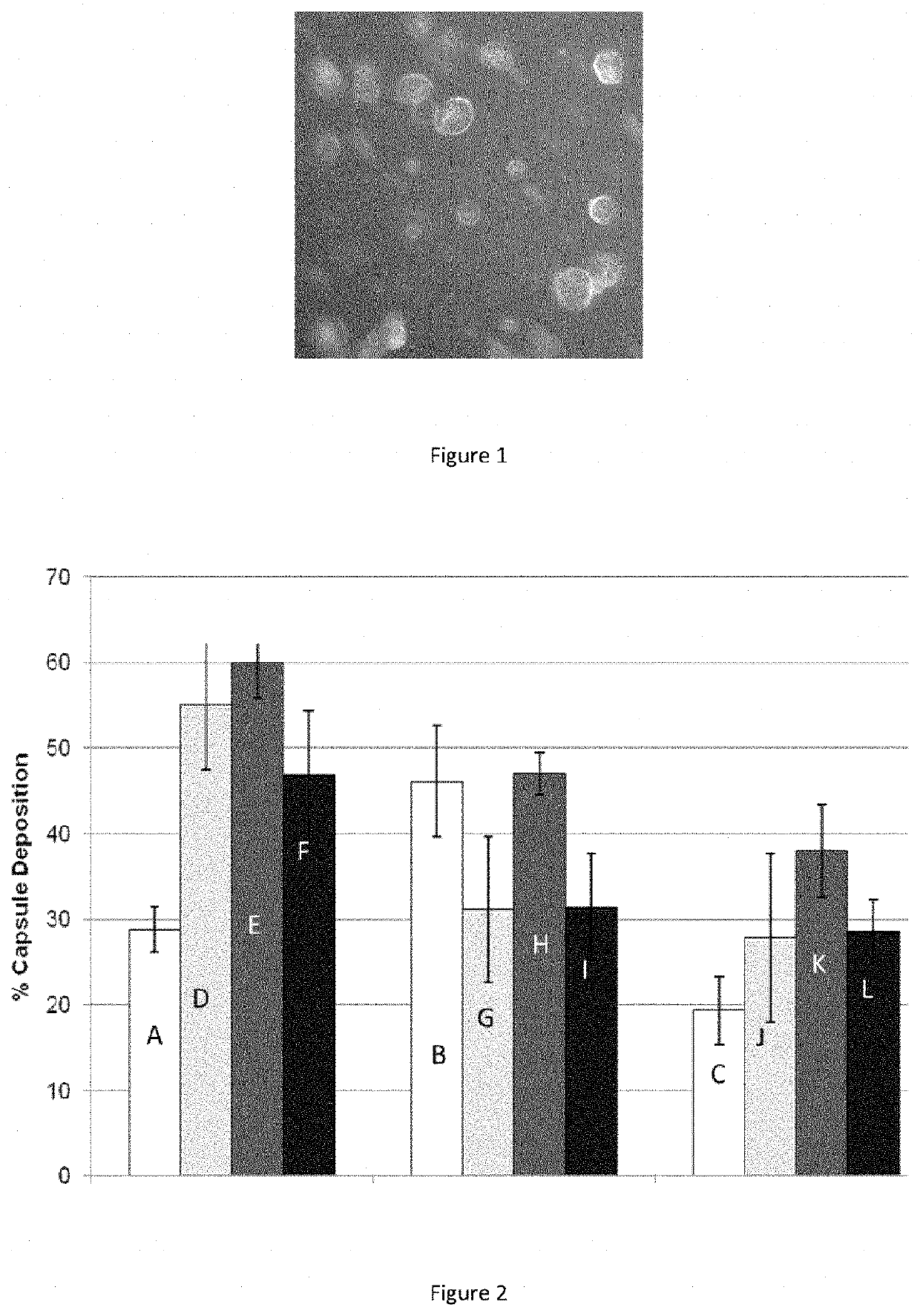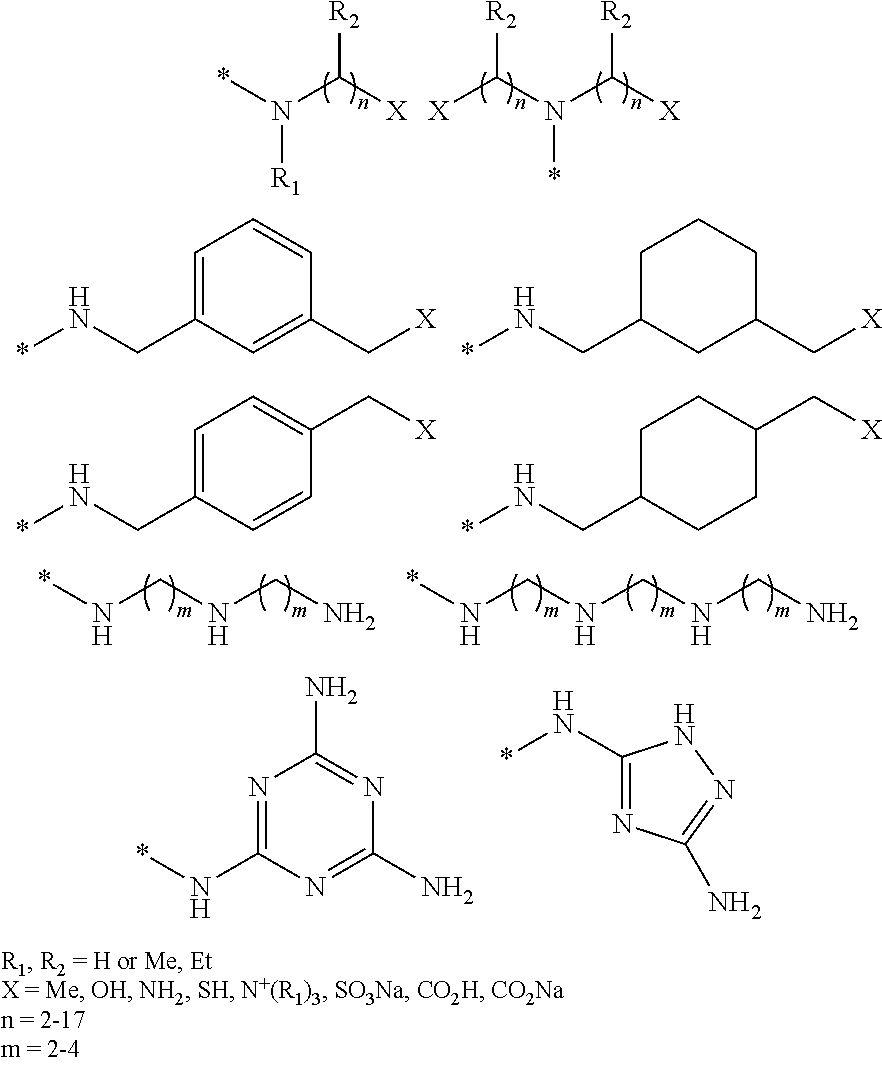Process for preparing polysuccinimide derivatives-based microcapsules
a technology of derivatives and microcapsules, applied in the preparation of detergent mixtures, detergent compounding agents, hair cosmetics, etc., can solve the problems of difficult stability of microcapsules, high levels of aggressive surfactant detergents in fragranced personal and household cleansers, and relative rapid loss of olfactive benefits of odoriferous compounds, etc., to achieve good performance
- Summary
- Abstract
- Description
- Claims
- Application Information
AI Technical Summary
Benefits of technology
Problems solved by technology
Method used
Image
Examples
example 1
[0246]Preparation of Polysuccinimide Derivatives
[0247]Preparation of polysuccinimide (PSI, 1)
[0248]In a 250 ml, beaker, orthophosphoric acid (10 g, 0.114 mmol) and L-Aspartic Acid (100 g, 751 mmol) were respectively added and mixed in a mortar to give a white solid. Solid was heated at 120° C. for 1 h under vacuum in a three-nicked reactor. Solid was crushed in a mortar and it was heated at 200° C. for additional 2 h 30 under vacuum. Resulting powder was washed 3 times with 500 mL of water, then with NaOH 30 wt % to obtain an aqueous phase at pH 4 after filtration. Solid was then dried under vacuum at 50° C. for at least 24 h.
[0249]Preparation of polysuccinimide-co-poly(n-dodecylaspartamide) (2)
[0250]In a 250 mL round-bottomed flask, 1 (15 g, 155 mmol of repeating units) was dissolved in NMP (150 mL) and heated at 80° C. to give a yellow-orange solution. 1-Dodecylamine (DDA) (5, 10 or 20 mol % with respect to PSI repeating units) was added into the solution, in several fractions. Th...
example 2
[0255]Preparation of microcapsules according to the invention
[0256]Desmodur® N-100 (4.76 g, 24.5 mmol NCO) and Acridine (0.25 g—compound added to follow the deposition) were diluted into the perfume oil (20.74 g, Table 2). The copolymer 2 or 3 (0.7 g) were diluted into an aqueous buffered solution at pH 7 (31.57 g). The oil and aqueous phases were mixed together, and then dispersed with Ultra Turax for 3 min at 24 000 rpm. The emulsion was put into a 250 mL glass double jacketed reactor and agitated at 350 rpm at room temperature. A solution of guanidine carbonate (24.5 mmol) into an aqueous buffered solution at pH 7 (10.85 g) was added dropwise into the emulsion for 1 h. Then, the temperature of the reaction mixture was slowly increased from room temperature to 70° C. in 4 times every 15 minutes (RT; 40° C.; 50° C.; 60° C.; 70° C.) and then kept at 70° C. for 2 h. Finally, the agitation was reduced at 100 rpm and the dispersion was cooled down to room temperature.
TABLE 2perfume oil...
example 3
[0257]Preparation of comparative microcapsules X
[0258]A solution of poly(vinyl alcohol) in water (45 g, 0.5 wt %, Mowiol 18-88, origin: Aldrich, Switzerland) was introduced in a beaker. A solution of perfume oil A (see table 1, 38 g) and polyisocyanate (0.27 g, Takenate® D-110N, Origin: Mitsui Chemicals, Japan) was introduced into the beaker. The reaction mixture was stirrer at 24,000 rpm with an Ultra Turrax for 2 min at room temperature (RT). A solution of guanidine carbonate (0.88 g, Origin: Aldrich, Switzerland) in water (4 g) was added dropwise with a syringe pump at room temperature over the course of 1 h. The resulting emulsion was warmed up to 70° C. over the course of 1 h. Temperature was maintained at 70° C. for 2 h and then cooled down to RT to afford a white dispersion (pH=9.7).
PUM
| Property | Measurement | Unit |
|---|---|---|
| logP | aaaaa | aaaaa |
| logP | aaaaa | aaaaa |
| logP | aaaaa | aaaaa |
Abstract
Description
Claims
Application Information
 Login to View More
Login to View More - R&D
- Intellectual Property
- Life Sciences
- Materials
- Tech Scout
- Unparalleled Data Quality
- Higher Quality Content
- 60% Fewer Hallucinations
Browse by: Latest US Patents, China's latest patents, Technical Efficacy Thesaurus, Application Domain, Technology Topic, Popular Technical Reports.
© 2025 PatSnap. All rights reserved.Legal|Privacy policy|Modern Slavery Act Transparency Statement|Sitemap|About US| Contact US: help@patsnap.com



